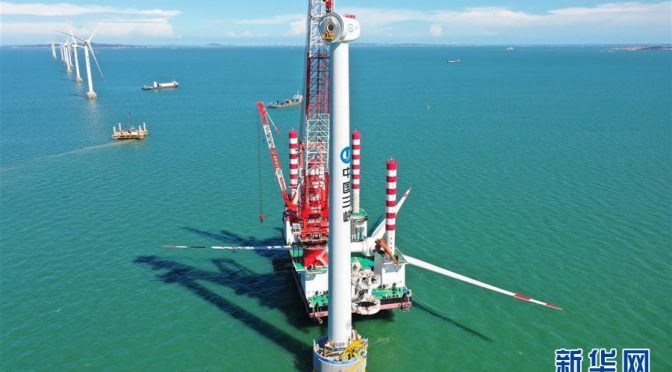From its first 102 MW Donghai Bridge Wind Farm near Shanghai commissioned in 2010, China has since been busy building swathes of turbines at sea with nearly 7 GW of capacity already installed as of December 2019. While China is considered a late bloomer in the offshore wind industry, it is expected to surpass offshore wind pioneers like Germany and the UK in terms of cumulative installations by as early as this year.
Now the question on everyone’s mind is: what’s next for China’s offshore wind industry? GWEC Market Intelligence outlines our forecasts for this booming market, as well as the opportunities and challenges ahead to further accelerate the growth of China’s offshore wind industry.
52 GW of offshore wind capacity expected over the next decade
Although the COVID-19 crisis first hit China, this has not slowed down the growth of offshore wind in the country. With the current Feed-in-Tariff for offshore set to expire by the end of 2021 and no signs of this deadline being extended, GWEC Market Intelligence expects that there will still be an installation rush to meet this deadline, with 11.4 GW of new capacity expected to come online from 2019 to 2021.
After this surge of new installations, the market is expected to see a peak in 2021 followed by a drop when the central government will terminate the subsidy for offshore wind. However, growth given China’s huge offshore wind potential and market size, GWEC Market Intelligence expects growth to continue with an average of 4.77 GW of annual capacity added from 2022 to 2030.
With this predicted growth along with a wave of policy, technology and market developments in favour of further driving the offshore wind industry, GWEC expects that China will surpass the UK as the world’s largest offshore market in total installations by 2021, if not 2020.
In total, 52 GW of offshore wind capacity is expected to be grid-connected nationwide from 2019 to 2030. Jiangsu, Fujian and Guangdong provinces will continue to lead the market growth – as of the end of 2019, these 3 regions hold 80.8 per cent of the country’s offshore wind capacity and will contribute significantly of the new build additions in the next 10 years.
Feed-in Tariff policy changes and supply chain bottlenecks are creating uncertainty in the medium-term
At present, project developers and investors are rushing to commission their projects before the end of the 2021 deadline in order to lock in a premium offshore wind Feed-in Tariff (0.75 – 0.85 RMB/kWh) for 20 years and be free from price competition (and price cut) under competitive tender pricing with coal generation.
Although offshore wind CAPEX has been reduced by 40-50 per cent in China over the past decade, the current levelized cost of electricity (LCOE) for the Chinese offshore market is still at CNY 0.64/ kWh (EUR 0.08/kWh). This means that there is a significant price gap between the current LCOE of offshore wind and that of coal-generated electricity, and without the feed-in-tariff to level the playing field, there is great uncertainty for the sector in the medium term.
In addition, there is also uncertainty in regards to if projects will be able to make the 2021 deadline for the feed-in-tariff, given the current supply chain disruptions caused by COVID-19 and pre-existing supply chain issues where demand has exceeded supply as the installation rush has put intense pressure on the country’s nascent offshore wind supply chain.
Currently, bottlenecks in vessel supply are said to be the main barrier, followed by the manufacturing of key components such as large blades, main bearings, and offshore cables. Ultimately, these supply chain bottlenecks may limit the potential volume of offshore wind able to meet the grid-connection deadline for all approved projects.
Despite these challenges and risk of projects not meeting the deadline, GWEC Market Intelligence remains optimistic that these projects will continue to be developed even after the 2021 deadline to avoid even further policy changes.
Big ambitions will continue to drive growth
While the termination of support by the central government will slow down China’s offshore wind growth of China in the medium-term, GWEC Market Intelligence believes that this move will push the Chinese offshore wind industry to reach grid parity earlier than expected.
The strongest factor that may mitigate this financial uncertainty of subsidy-free procurement and further drive down LCOE is the strong political commitment of China’s government to continue accelerating the development of renewable energy under the context of a green recovery and achieving their Paris Agreement commitments.
From a national perspective, the recent pledge by President Xi for China to go carbon neutral by 2060 could open new doors for the offshore wind industry, which will place an increasingly important role in the country’s decarbonisation strategy, especially for the energy-hungry eastern coastal regions such as Jiangsu, Guangdong and Fujian.
From a provincial perspective, the recently issued ‘Guangdong Province Action Plan for Cultivating New Energy Strategic Emerging Industrial Clusters (2021-2025)’ has unveiled the province’s plan to speed up development of offshore wind and technology advancements, which includes achieving parity by 2025 by supporting R&D and developing offshore wind clusters in Yangjiang and Eastern Guangdong. Provincial support of the offshore wind industry will become even more important post-2021 as the central government subsidy comes to an end.
Such announcements provide long-term visibility and scale for the local industry, and we expect that annual offshore wind growth in China is likely to exceed our expectations, as we have already seen over the past few years. It is clear that China is on track to lead the transition from traditional energy sources such as coal, to wind and other renewables – and offshore wind will be a key piece in the country’s energy transition puzzle.
For more information on China’s offshore wind market and other emerging markets for offshore wind, download GWEC’s Global Offshore Wind Report 2020 here.


